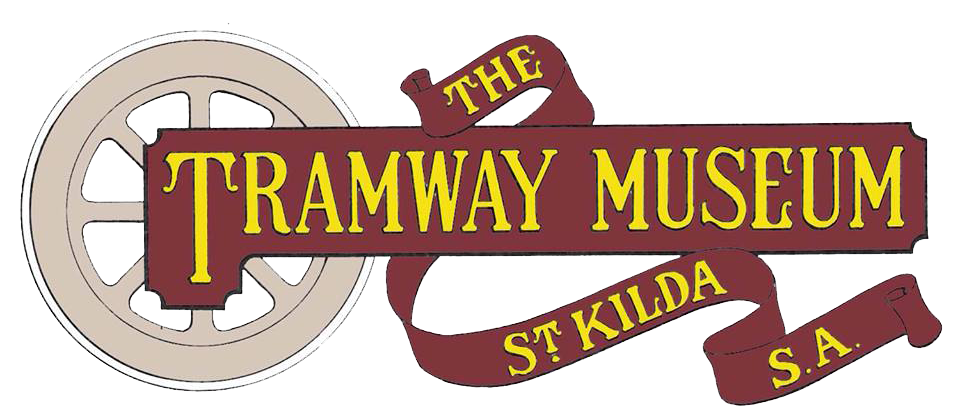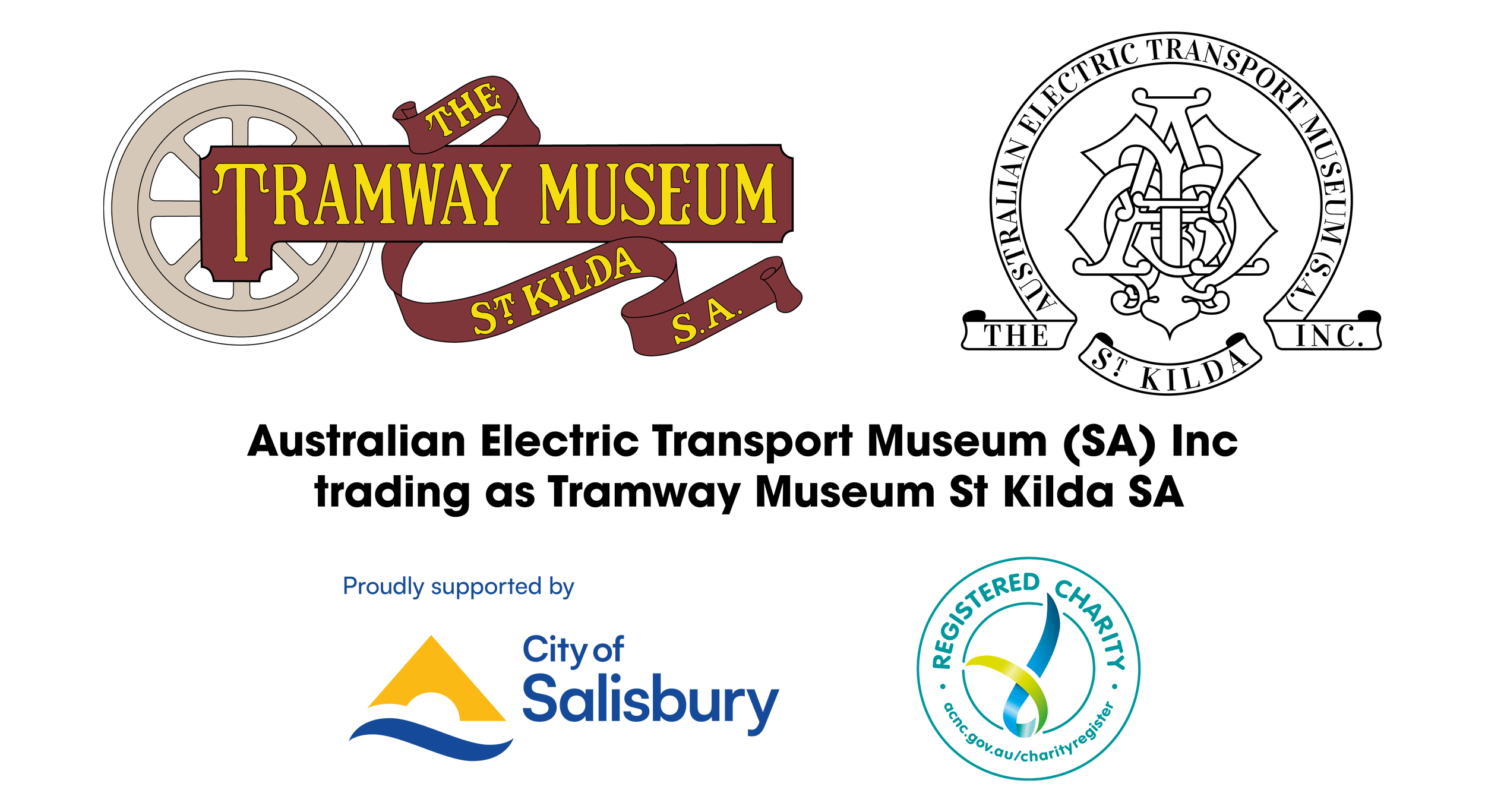The Eastern Lines
A photo from the Tramway Museum archives showing an unidentified F or F1 type 'Drop Centre' tram running through the peaceful country side on the Morialta line at Rostrevor with the tram heading towards the Adelaide city centre in 1954, two years before closure of this line in March 1956.
Morialta
The foothills fill with with houses:
The single-track line to Morialta was built from Magill for tourists in 1915. It carried heavy weekend traffic, but only had one tram trip each way on weekdays. Built on the side of ‘country style’ roads with little other traffic, the journey to the edge of the reserve and a walk to the Falls was a pleasure.
After the Second World War Magill, Woodforde and Rostrevor began developing. The new suburbs filled with houses. Road construction was needed; the old unsealed tramline was a motoring hazard and visitors to Morialta largely travelled in their own cars. Other suburbs expanded at Firle and Hectorville. From March 17 1956 buses replaced the trams.
They travelled on a new route to the city via Firle, which had been the intended terminus of a never built tramline, and then on to Rostrevor. This allowed major road reconstruction, which was particularly needed from the Tower Hotel along St. Bernard’s Road.
'Drop Centre' tram 265 can be seen from a Magill bound tram leaving the Tranmere crossover on Magill Road in the mid 1950s. As well as the main Magill line and the Morialta branch, 'short working' services were provided on this line with Maylands and Tranmere being alternative destinations. Photo: Keith Kings.
Magill
Up the hill to Magill:
Another line developed by the Adelaide and Suburban Tramway Company ran from the City along Magill Road. Initially services ran from Maylands but by August 1883, tram services started from Magill. A horse tram depot was established at Maylands to accomodate both the horses and the tram cars that they pulled. In later years, Maylands depot would be used after electrification for use as a 'permanent way store' (permanent way being a term referring to the tracks that the trams run on).
Horse tram services were replaced with electric trams by the Municipal Tramways Trust with the opening of the electric line to Maylands occuring in May 1909 with the rest of the line to Magill being converted to electric traction by December 1911, tram services stopping opposite the Tower Hotel. A short extension beyond the Tower Hotel was made with the line running to the bottom of Norton Summit Road was opened in February 1912.
Tram services on the line to Magill ceased in February 1957 after which services were replaced with buses. Despite the end of trams running on Magill Road, the former Mayland depot would continue to be a tram hold out in to the 1960s. After its' withdrawl from service in 1957, the solitary H1 type tram no.1 was held in storage instead of being immediately cut up. For a few years until 1965, it was stored in the former tram shed until it was brought out and delivered to the Tramway Museum, St Kilda for preservation.
A feature of the Kensington Gardens line was a short section of 'reserve track' that ran through the Eastern Parklands at Rymill Park on an embankment. Seen here is an H type tram on a service leaving the City bound for Kensington Gardens in the mid 1950s. Normally associated with the Glenelg line, the H type trams were a common sight on the line from 1952 until closure in 1957. Photo: Keith Kings.
Kensington Gardens
The first horse and electric tramway:
The suburbs of Norwood and Kensington were the first in Adelaide to be served by a permanent street based public transport service and was also the first to be served by electric trams. The first horse tram company formed was the Adelaide and Suburban Tramway Company which commenced laying track for the new service from the City to Norwood and Kensington and 1877 and the new service was opened in June 1878. Prosperity for the company followed and it became the largest of the various horse tram operators and eventually ran lines to other parts of the City.
After the formation of the Municipal Tramways Trust, the Adelaide and Suburban Tramway Company was acquired and the line to Kensington was converted to electric operation. A procession of trams led by tram no.1 (now preserved at St Kilda) ran to the interim Kensington terminus at the intersection of The Parade and Gurrs Road to mark the opening of the first electric tram line in Adelaide. The new service was an immediate success. An extension of the tramline was made to Kensington Gardens to serve the new reserve that had been developed (now Kensington Gardens Reserve). This reserve had been developed by the Municipal Tramways Trust and was used to help generate additional 'tourist' traffic for the tram system. A bandstand was one of the features of the new reserve where the tramways own band would perform concerts for patrons who would arrive by tram, there by further increasing ticket sales. A third track acting as a siding was also built near Norwood Oval to accomodate trams transporting passengers attending football games there.
For most of the 48 years the line was operated, services were linked in and 'through worked' to other eastern suburbs lines or terminated in Grenfell Street in the City but after 1952, the service was 'though routed' with trams running to Henley Beach. The last trams to both Kensington Gardens and Henley Beach ran in February 1957 and the first tramway in Adelaide was closed.
D type trams were the regular tram type in the south eastern suburbs. D 158 is on the short Erindale branch at the intersection of Kensington Road and Burnside Road, heading for the terminus in May 1952, just days before closure. Photo: Wal Jack.
Erindale
Last to arrive, first to go:
In the late 1930s, the first 'feeder' bus service was provided from the suburb of Erindale which connected with trams on the Burnside line at Marryatville. The bus service wasn't successful and had stopped running in 1938. In early 1943, Lewis Brother's private bus service operated another tramway 'feeder' service on a different route to the first route, a service that was to ultimately prove successful.
The Municipal Tramways Trust made the decision to extend tramway services to Erindale with the short branch line leaving the main Burnside line at the intersection of Tusmore Avenue and Kensington Road, proceeding along Kensington Road to terminate at the intersection with Jarvis Street. Built with second hand material which had been recovered from the former Port Adelaide tramway system, the new line was opened in January 1944. This would be the final tramway extension in Adelaide until 2007 (when the Glenelg line was extended to City West).
The years during the Second World War placed a huge strain on all public transport services in Adelaide. In the immediate Post War period, the Municipal Tramways Trust was not only facing up to the need to renew the tramway and trolley bus system but also to reduce mounting financial losses. Despite being opened in 1944, the Erindale line (as well as many of the other lines in the South Eastern suburbs) were still being principally operated by the ageing D type trams which dated back to 1912 as well as the even older A type trams. New trolleybuses were being delivered to Adelaide and the decision was made to replace the trams to Erindale, Burnside and Linden Park with the new vehicles. After an operating life of only 8 years, the line to Erindale was closed in May 1952.
D type tram 146 is seen at the terminus of the Burnside line before making a return trip to the City in 1952. Photo: Wal Jack.
Burnside
Destination Burnside:
The first part of what became the Burnside tramline was opened as a horse tram service by the Adelaide and Suburban Tramway Company in July 1883 serving the suburb of Marryatville. Built as a branch off the main Kensington line, the new Marryatville service ran along Dequetteville Terrace and Kensington Road to the new terminus. Soon, work was in progress to extend the tramway in to Burnside itself with the extension running through Tusmore Avenue, Rochester Street, Philip Avenue, Knightsbridge Road and Glynburn Road before terminating at the intersection with Greenhill Road. Extra facilities were provided cater for weekend 'picnic' traffic using the new line to access Heywood Park or even Waterfall Gully (despite the long walk from the tram terminus!)
Conversion of the Burnside line to electric operation was carried out by the Municipal Tramways Trust with electric trams running to the temporary Marryatville terminus at the intersection of Kensington Road and Shipsters Road in November 1909. The new electric trams were re-routed from Dequetteville Terrace and instead accessed the City via Wakefield Street. The rest of the line to Burnside had been electrified by September 1911 on the same route as the horse tram line but with a minor extension one block further south with the new tram terminus at the intersection of Glynburne Road and Waterfall Terrace.
The Burnside line appeared to enjoy a relatively quiet existence throughout its years of operation. Along with the Erindale branch and neighbouring Linden Park line, the line to Burnside was closed in May 1952.
City bound D type tram 143 is about to pass tram 161 on a service to Linden Park, seen turning in to Stuart Road from Greenhill Road in 1951. Photo: Wal Jack.
Linden Park
Trams serving what became Burnside Village Shopping Mall:
Linden Park was one of the suburbs that was never reached by horse tram and was finally included on the tramway network in 1924. The first form of public transport in the area was a horse bus service which was started by the Adelaide and Suburban Tramway Company in the last years of the company before being taken over by the Municipal Tramways Trust. Operated as a 'feeder' service to what later became the Burnside line from the intersection of Kensington Road and Gurney Road, the horse bus ran to Dulwich at the intersection of Stuart Road and Union Street. After initially considering opening a new electric service to Dulwich with trolley buses (then a new technology in the early stages of development), electric trams started to operate to Dulwich by 1914. Trams ran just beyond the old horse bus terminus in Stuart Road, terminating at the intersection with Greenhill Road. The new service was run via Fullarton Road, Dulwich Avenue as well as Stuart Road. Originally built as a single track line, the track to Dulwich was duplicated at the same time as the line was extended to Linden Park.
By the early 1920s, the main centre of the suburbs in the area was a group of shops located at the intersection of Greenhill Road and Portrush Road (the area now occupied by the Burnside Village shopping mall). The Dulwich tram line was extended along Greenhill Road and Portrush Road to terminate at Sturdee Road in Linden Park to serve this new shopping area. This new extension was opened to traffic in October 1924.
Despite serving this new shopping area which created additional traffic for the line, Post War pressures which conspired against the operation of the Erindale and Burnside lines (and ultimately the rest of the Adelaide tramway system apart from the Glenelg line) would see the last trams to Linden Park operate in May 1952. All three lines to Linden Park, Burnside and Erindale were closed on the same day.








